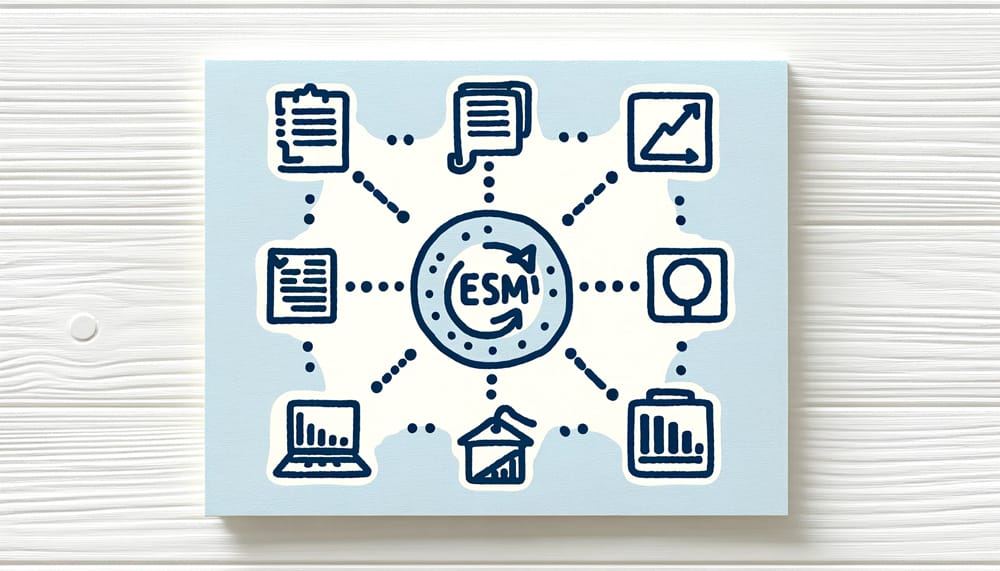Introduction to ESM in Longitudinal Research
Experience Sampling Method (ESM) has emerged as a powerful tool in longitudinal research, offering unique insights into how individuals’ experiences, behaviors, and perceptions evolve over time. The application of ESM in such studies represents a significant advancement in understanding the dynamic nature of human experiences. For further insights into the foundational aspects of ESM, Introduction to Experience Sampling Method (ESM) provides a comprehensive overview.
Overview of the Application of ESM in Longitudinal Studies
In longitudinal research, ESM is used to collect data at multiple points over an extended period. This approach is particularly valuable in fields like psychology, education, and health sciences.
Gain insights into the nuances of setting the right frequency and timing for data collection in Experience Sampling Method (ESM) research by exploring our informative guide, Balancing Frequency and Timing in Experience Sampling Method (ESM): A Researcher’s Guide. This resource offers valuable advice for researchers on how to optimize these crucial aspects in ESM studies. Similarly, in educational settings, ESM helps track students’ learning experiences and engagement over an academic term or year.
The Significance and Potential of ESM in Tracking Changes Over Time
The use of ESM in longitudinal studies offers several significant advantages:
-
- Capturing Dynamic Processes: ESM allows for the observation of changes in behaviors, thoughts, and feelings as they naturally occur, providing a more nuanced understanding of dynamic processes.
-
- High Ecological Validity: By collecting data in real-world settings, ESM enhances the ecological validity of research findings. This real-time data collection helps in capturing experiences in their natural context.
-
- Rich Data Sets: Longitudinal ESM studies generate rich, detailed datasets that offer deep insights into temporal patterns and long-term trends.
-
- Personalized Insights: ESM enables the collection of personalized data, which can be crucial in tailoring interventions or educational strategies to individual needs.
“ESM in longitudinal research opens a window into the evolving tapestry of human experiences, shedding light on the intricate patterns of change that define our lives over time.”
The incorporation of ESM into longitudinal studies not only enhances the depth and quality of research but also paves the way for innovative approaches in understanding and addressing complex, time-sensitive phenomena. As we delve deeper into the challenges and solutions in longitudinal ESM research, the potential of this method in providing transformative insights becomes increasingly evident.
Unique Challenges of Longitudinal ESM Studies

Longitudinal Experience Sampling Method (ESM) studies, while rich in potential, come with a unique set of challenges. These challenges, if not properly addressed, can significantly impact study outcomes and the quality of the data collected.
Specific Challenges Encountered in Longitudinal ESM Research
-
- Participant Fatigue and Dropout: Over time, participants may experience fatigue or lose interest, leading to decreased response rates or dropout. Participant fatigue and dropout can result in biased data or reduced sample sizes, affecting the study’s validity.
-
- Maintaining Data Quality Over Time: Ensuring consistent data quality throughout the study can be challenging. This includes maintaining the accuracy and reliability of responses. Inconsistent data quality can lead to difficulties in interpreting long-term trends, as explored in Analyzing ESM Data: A Guide.
-
- Technological Issues and Evolution: Longitudinal studies may face technological challenges, such as changes in software, updates to devices, or data synchronization issues. As noted in Technological Innovations in ESM, the evolving nature of technology necessitates constant adaptation to ensure seamless data collection.
-
- Complexity in Data Analysis: Analyzing the voluminous and complex data generated in longitudinal ESM studies poses significant challenges. This complexity is heightened when integrating qualitative and quantitative data streams. The need for sophisticated analytical techniques, as discussed in ESM Data Visualization Techniques, is crucial for extracting meaningful insights from longitudinal data.
Analyzing How These Challenges Affect Study Outcomes and Data Quality
-
- Bias and Generalizability Issues: Participant dropout and fatigue can lead to biased samples if certain groups are more likely to discontinue participation. This bias impacts the generalizability of the findings.
-
- Temporal Data Inconsistencies: Fluctuations in data quality over time can lead to inconsistencies, making it challenging to identify genuine trends or changes.
-
- Interpretational Difficulties: The complexity and volume of data in longitudinal ESM studies can lead to difficulties in interpretation, especially when trying to distinguish between short-term fluctuations and long-term patterns.
“Navigating the unique challenges of longitudinal ESM research is akin to steering a ship through changing seas. Adaptability, foresight, and robust methodologies are key to maintaining course towards meaningful insights.”
Addressing these challenges requires thoughtful planning, innovative solutions, and a deep understanding of the methodological intricacies of longitudinal ESM research. By overcoming these hurdles, researchers can unlock the full potential of ESM in capturing the evolving landscape of human experiences.
Participant Engagement Over Time in Longitudinal ESM Studies

Maintaining participant engagement over time in longitudinal Experience Sampling Method (ESM) studies is critical for ensuring the quality and reliability of the data collected. Participant fatigue and dropout pose significant challenges in long-term studies, potentially impacting the study’s outcomes.
Strategies to Maintain Participant Engagement in Long-Term Studies
-
- Regular Communication and Feedback: Keep participants engaged through regular communication. Updates on the study’s progress or sharing preliminary findings can maintain interest. Providing feedback, as emphasized in Participant Engagement in ESM Studies, helps participants feel their contributions are valuable and meaningful.
-
- Incentivization and Rewards: Implement a system of incentives or rewards to motivate continued participation. This could include monetary compensation, gift cards, or other forms of recognition.
-
- Minimizing Participant Burden: Simplify the data collection process as much as possible. This could involve reducing the frequency of prompts or using more user-friendly data collection methods. Utilize technological solutions, as discussed in Technological Innovations in ESM, to make participation more convenient and less time-consuming.
-
- Personalized Interaction: Build a rapport with participants through personalized interactions. Personalized communication can be more engaging than generic contact. Adjust the study design based on participant feedback, fostering a sense of collaboration.
Addressing the Issue of Participant Fatigue and Dropout
-
- Flexible Participation Options: Offer participants flexibility in how they respond to ESM prompts. This could include allowing them to choose times for data submission or opting out of certain prompts. Flexibility can reduce the feeling of being overwhelmed, as noted in challenges faced by participants in Challenges and Solutions in ESM Research.
-
- Monitoring Engagement Levels: Regularly monitor engagement levels and reach out to participants showing signs of fatigue or disinterest. Early intervention can help address concerns or obstacles that participants may be facing.
-
- Adaptive Study Design: Be prepared to adapt the study design in response to participant feedback or declining engagement levels. This adaptability can help maintain interest and participation over the course of the study.
“In longitudinal ESM research, sustaining participant engagement is not just about collecting data; it’s about fostering a journey of shared discovery and mutual respect.”
By implementing these strategies, researchers can effectively maintain participant engagement in longitudinal ESM studies, mitigating the risks of fatigue and dropout. Engaged participants not only contribute richer data but also enhance the overall validity and impact of the research.
Data Consistency and Quality in Longitudinal ESM Studies

Maintaining data consistency and quality over the duration of a longitudinal Experience Sampling Method (ESM) study is pivotal for ensuring the reliability and validity of the research findings. Consistency in data collection and the sustained quality of data are essential to accurately interpret longitudinal changes.
Ensuring Consistent Data Collection Throughout the Study Duration
-
- Standardized Data Collection Procedures: Develop and adhere to standardized procedures for data collection. This includes consistent timing for prompts and uniform question formats. Consistency in methodology is crucial, as highlighted in Designing an ESM Study: Key Considerations.
-
- Training and Support for Participants: Provide thorough training and ongoing support to participants. Clear instructions and readily available assistance can help maintain consistent data collection practices. As seen in Participant Engagement in ESM Studies, engaged and well-informed participants are more likely to provide consistent data.
-
- Regular Monitoring and Quality Checks: Conduct regular checks on the data collected to identify and address any inconsistencies early. Monitoring can involve assessing response patterns and data completeness. Utilize software features, as discussed in Technological Innovations in ESM, for automated quality checks.
Techniques for Maintaining Data Quality over Extended Periods
-
- Adaptive Study Design: Be prepared to make adjustments to the study design if certain aspects are not yielding high-quality data. Flexibility in study design can help address unforeseen challenges. Adaptation could include altering prompt frequencies or refining questionnaires based on participant feedback.
-
- Participant Feedback Mechanisms: Implement mechanisms for participants to provide feedback on the data collection process. Participant input can be invaluable in identifying issues affecting data quality. Feedback mechanisms enhance participant involvement, thereby potentially improving data quality.
-
- Data Cleaning and Processing: Employ robust data cleaning and processing techniques to ensure data quality. This includes handling missing data, outliers, and any anomalies. Advanced data processing methods, as explored in Analyzing ESM Data: A Guide, can help maintain data integrity.
-
- Ethical Considerations: Ensure ethical practices in data collection and handling, as improper practices can affect data quality. Adhering to ethical guidelines, such as those in Ethical Considerations in ESM Research, is essential.
“In longitudinal ESM studies, consistency and quality of data are not just metrics of research rigor; they are the pillars that support the edifice of meaningful and impactful findings.”
By focusing on these strategies, researchers can ensure that their longitudinal ESM studies produce consistent, high-quality data, enabling them to draw reliable and insightful conclusions over time.
Managing and Analyzing Longitudinal ESM Data

Effective management and analysis of the large, complex datasets typical of longitudinal Experience Sampling Method (ESM) studies are crucial for uncovering valuable insights. The long-term nature of these studies often results in voluminous data, necessitating strategic handling and sophisticated analysis methods.
Best Practices for Handling Large, Complex Datasets in Longitudinal ESM
-
- Efficient Data Management Systems: Implement robust data management systems that can handle large volumes of data efficiently. This includes databases capable of storing and organizing complex datasets over extended periods. Consider the use of cloud-based solutions for scalability and accessibility, as seen in Technological Innovations in ESM.
-
- Standardization of Data Formats: Maintain consistency in data formats throughout the study. Standardizing formats facilitates easier aggregation and analysis of data collected over time. Consistent data formats are particularly crucial in studies where data is often collected across different educational contexts and periods.
-
- Routine Data Cleaning and Quality Checks: Regularly clean and perform quality checks on the data to ensure accuracy and reliability. This involves identifying and correcting errors, dealing with missing data, and validating data entries. Data cleaning is a critical step outlined in Analyzing ESM Data: A Guide.
Methods for Analyzing Data to Identify Trends and Patterns Over Time
-
- Time-Series Analysis: Employ time-series analysis techniques to examine trends, cycles, and patterns in the data over time. This method is particularly effective for identifying changes in behaviors or states across different time points. Time-series analysis can provide insights into temporal dynamics, as discussed in ESM Data Visualization Techniques.
-
- Multilevel Modeling: Utilize multilevel modeling to analyze data that is nested within individuals over time. This approach is suitable for accounting for both within-person and between-person variations. Multilevel models are particularly relevant in longitudinal ESM studies, where repeated measures are taken from the same participants.
Discover solutions for ESM challenges in longitudinal research in this insightful article.
- Multilevel Modeling: Utilize multilevel modeling to analyze data that is nested within individuals over time. This approach is suitable for accounting for both within-person and between-person variations. Multilevel models are particularly relevant in longitudinal ESM studies, where repeated measures are taken from the same participants.
-
- Advanced Statistical Techniques: Implement advanced statistical techniques like structural equation modeling (SEM) for complex data analysis. SEM can be useful for testing hypotheses about relationships between variables over time. These techniques are essential for handling the complexity of longitudinal ESM datasets and extracting meaningful conclusions. Uncover the potential of ESM in longitudinal studies through this detailed analysis.
“Managing and analyzing data in longitudinal ESM studies is a journey through a rich landscape of information, where the paths of data management and analytical rigor lead to the destination of insightful discoveries.”
Adhering to these best practices in data management and employing sophisticated analytical methods enable researchers to effectively navigate the complexities of longitudinal ESM data. This comprehensive approach ensures that the full potential of ESM in long-term studies is realized, leading to robust and insightful findings. Navigate ESM’s complexities in longitudinal studies with this essential read.
Ethical Considerations in Longitudinal ESM

Longitudinal Experience Sampling Method (ESM) studies, with their extended duration and frequent data collection, bring forth unique ethical challenges. Addressing these concerns is crucial for maintaining the integrity and credibility of the research.
Addressing Ethical Concerns Unique to Long-Term ESM Studies
-
- Sustained Informed Consent: In long-term studies, informed consent is not a one-time process. It’s vital to ensure that participants understand their ongoing involvement and consent to it throughout the study. Regular check-ins and updates, as emphasized in Participant Engagement in ESM Studies, can be an effective way to reaffirm consent and address any emerging concerns or changes in the study.
-
- Long-Term Privacy Considerations: Privacy concerns are magnified in longitudinal ESM studies due to the prolonged period over which personal data is collected. Implementing robust privacy protection measures and continually updating them, as discussed in Privacy Concerns in ESM, is critical for safeguarding participant data.
-
- Data Security Over Extended Periods: The security of data collected over long durations needs constant vigilance. This includes protecting data against evolving cyber threats and ensuring compliance with data protection laws. Utilizing state-of-the-art security technologies and practices, as outlined in Data Security in ESM Research, is essential for the safekeeping of sensitive data.
Focusing on Informed Consent, Privacy, and Data Security Over Extended Periods
-
- Dynamic Consent Processes: Adapt the consent process to be dynamic and reflective of the study’s evolving nature. This might include digital platforms that allow participants to modify their consent choices as the study progresses. Delve into solutions for typical obstacles encountered in Experience Sampling Method (ESM) research with our detailed guide, Overcoming Common Challenges in Experience Sampling Method (ESM) Research. This resource is dedicated to helping researchers navigate and resolve frequent challenges in ESM studies, ensuring more effective and reliable outcomes.
-
- Proactive Privacy Management: Regularly assess and address privacy risks, adapting to new challenges that may arise over the course of the study. Encourage participant feedback on privacy concerns, integrating their insights into privacy protection strategies.
-
- Continuous Data Security Monitoring: Implement ongoing monitoring and updating of data security measures to address new vulnerabilities and comply with changing regulatory landscapes. Training and awareness programs for research staff, as part of ethical research practices in Challenges and Solutions in ESM Research, are crucial for maintaining a high standard of data security.
“In longitudinal ESM research, ethical considerations are a continuous journey, demanding vigilance and adaptation to protect the rights and well-being of participants over time.”
By addressing these ethical concerns with diligence and foresight, researchers conducting longitudinal ESM studies can uphold the highest standards of ethical research, ensuring that their work remains respectful, secure, and valuable both to participants and the scientific community.
Technological Solutions for Longitudinal ESM

In the realm of longitudinal Experience Sampling Method (ESM) studies, technology plays a pivotal role in addressing various challenges. Innovations in ESM tools and software have greatly facilitated the efficiency and effectiveness of long-term research.
Utilizing Technology to Address the Challenges of Longitudinal ESM
-
- Automated Data Collection Systems: Automated systems streamline the data collection process, reducing the burden on participants and researchers alike. This includes apps and devices that can prompt responses at predetermined times. As highlighted in Technological Innovations in ESM, these systems can enhance the consistency and reliability of data collection over extended periods.
-
- Advanced Data Management Tools: Handling large datasets generated in longitudinal studies requires robust data management solutions. Cloud-based platforms offer scalability and ease of access, facilitating efficient data storage and retrieval. The integration of data management tools, as discussed in ESM Data Visualization Techniques, also aids in the organization and analysis of complex datasets.
-
- Real-Time Monitoring and Analytics: Technologies that enable real-time data monitoring allow researchers to track participation and engagement continuously, addressing issues like participant fatigue or dropout promptly. Advanced analytics tools, capable of processing large datasets quickly, provide valuable insights into emerging trends and patterns, as explored in Analyzing ESM Data: A Guide. You may also, enhance your understanding of creating impactful prompts in Experience Sampling Method (ESM) studies with our guide, Crafting Effective Experience Sampling Method (ESM) Prompts: Tips and Examples. This resource offers practical tips and illustrative examples to assist researchers in designing prompts that effectively elicit valuable responses in ESM research.
Innovations in ESM Tools and Software That Facilitate Long-Term Research
-
- Mobile and Wearable Technologies: The use of mobile apps and wearable devices has revolutionized ESM by providing convenient and unobtrusive ways for participants to provide data. Wearables, for example, can passively collect physiological data, and complementing self-reported measures. Discover the future prospects of Experience Sampling Method (ESM) research in our enlightening guide, Future Directions in Experience Sampling Method (ESM): Emerging Trends and Technologies. This article explores upcoming trends and technological advancements that are shaping the future of ESM research, providing valuable insights for researchers and practitioners in the field.
-
- Machine Learning and AI: Machine learning algorithms and AI can analyze large-scale longitudinal data more efficiently, identifying complex patterns and correlations that might be missed by traditional methods. These technologies also have the potential to predict participant dropout or engagement levels, enabling proactive measures to be taken.
-
- Customizable ESM Platforms: Flexible and customizable ESM platforms allow researchers to tailor the data collection process to the specific needs of their longitudinal studies. This customization can include adaptive sampling strategies, personalized participant interfaces, and tailored data collection frequencies.
“Leveraging technological advancements in longitudinal ESM research is not just about harnessing new tools; it’s about redefining the possibilities of what can be achieved in understanding human experiences over time.”
The thoughtful application of these technological solutions can greatly enhance the efficiency, effectiveness, and overall quality of longitudinal ESM studies. By embracing these innovations, researchers can overcome traditional barriers, paving the way for more in-depth and comprehensive long-term research.
Conclusion: Optimizing Longitudinal ESM Studies
Longitudinal Experience Sampling Method (ESM) studies represent a significant stride in understanding dynamic human experiences over extended periods. Successfully navigating the complexities of these studies requires a combination of strategic planning, technological innovation, and ethical consideration.
Summarizing Key Strategies and Solutions for Successful Longitudinal ESM Research
-
- Maintaining Participant Engagement: Implementing strategies such as regular communication, incentives, and simplified data collection processes is crucial for sustaining participant interest and reducing dropout rates.
-
- Ensuring Data Consistency and Quality: Employing standardized procedures, routine data cleaning, and quality checks are essential for maintaining the integrity of the data collected over time.
-
- Leveraging Technological Advancements: Utilizing advanced data management systems, real-time analytics, and mobile and wearable technologies enhances the efficiency and effectiveness of data collection and analysis.
-
- Adhering to Ethical Standards: Maintaining ethical practices in informed consent, privacy, and data security throughout the study’s duration is fundamental for upholding the research’s integrity.
Final Thoughts on Maximizing the Potential of ESM in Long-Term Studies
In the quest to unravel the layers of human experiences, longitudinal ESM studies offer an unparalleled lens. The rich, nuanced data gathered can illuminate patterns and changes that would otherwise remain hidden. By embracing the outlined strategies and solutions, researchers can overcome the inherent challenges of longitudinal ESM, unlocking its full potential to yield profound and impactful insights.
“In the tapestry of longitudinal ESM studies, each thread of data weaves a story of change and evolution. It is through the meticulous crafting of these studies that the intricate patterns of human experience are revealed.”
As researchers continue to explore and optimize the use of ESM in longitudinal studies, the scope for discovery and understanding broadens. The key lies in balancing methodological rigor with innovative approaches, ensuring that every phase of the research contributes to a comprehensive understanding of the study’s subject.
You Might Also Be Interested:
Delve into our comprehensive ESM Article Collection for insightful perspectives on Experience Sampling Method (ESM).
See our article Best Tools for Experience Sampling Method in 2024 to discover the top tools in the field.
Learn how the advanced features of Fibion Insight can aid your ESM research.
Planning an ESM study? For a chat with our ESM expert, book a session with Dr. Miriam Cabrita.
Frequently asked questions about this topic
What advantages does ESM offer in longitudinal studies?
+
ESM offers the advantage of capturing dynamic processes with high ecological validity in real-world settings. It provides rich, detailed datasets for personalized insights into temporal patterns and long-term trends.
What are the unique challenges of longitudinal ESM studies?
+
Challenges include participant fatigue and dropout, maintaining data quality over time, technological issues, and the complexity of data analysis, which can impact study outcomes and data quality.
How can participant engagement be maintained in longitudinal ESM studies?
+
Maintaining engagement involves regular communication, incentivization, minimizing participant burden, personalized interaction, and offering flexible participation options.
What strategies ensure data consistency and quality in longitudinal ESM?
+
Strategies include standardized data collection procedures, training and support for participants, regular monitoring and quality checks, and adaptive study design.
What role does technology play in longitudinal ESM studies?
+
Technology in longitudinal ESM facilitates automated data collection, advanced data management, real-time monitoring and analytics, and the use of mobile and wearable technologies for efficient data gathering.
What ethical considerations are important in longitudinal ESM research?
+
Ethical considerations include sustained informed consent, long-term privacy concerns, continuous data security monitoring, and ensuring the ethical use of technology throughout the study.


 Delve into our comprehensive
Delve into our comprehensive  See our article
See our article  Learn how the advanced features of
Learn how the advanced features of  Planning an ESM study? For a chat with our ESM expert,
Planning an ESM study? For a chat with our ESM expert, 








